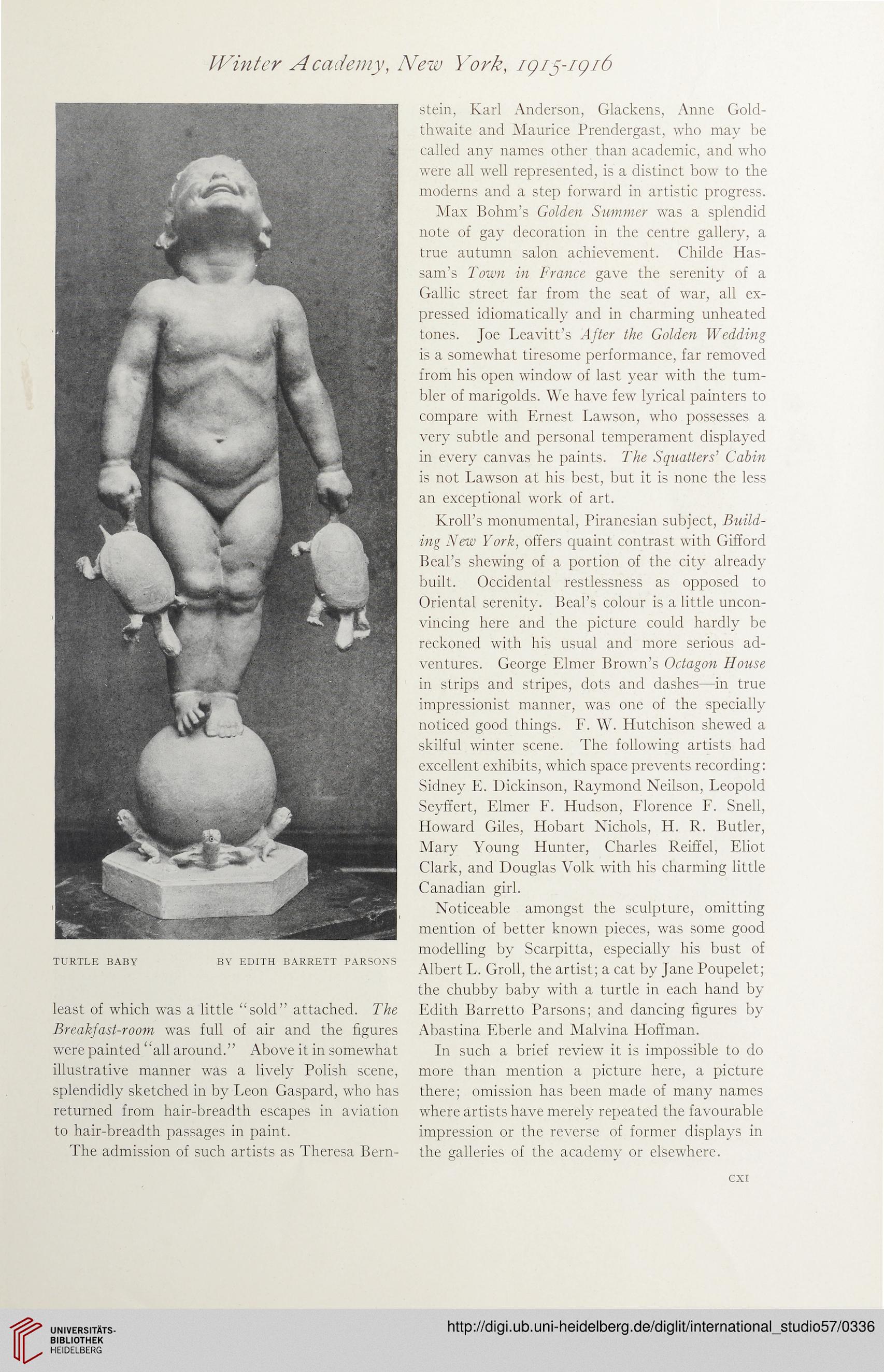Winter Academy, New York, 1915-1916
TURTLE BABY BY EDITH BARRETT PARSONS
least of which was a little “sold” attached. The,
Breakfast-room was full of air and the figures
were painted “all around.” Above it in somewhat
illustrative manner was a lively Polish scene,
splendidly sketched in by Leon Gaspard, who has
returned from hair-breadth escapes in aviation
to hair-breadth passages in paint.
The admission of such artists as Theresa Bern-
stein, Karl Anderson, Glackens, Anne Gold-
thwaite and Maurice Prendergast, who may be
called any names other than academic, and who
were all well represented, is a distinct bow to the
moderns and a step forward in artistic progress.
Max Bohm’s Golden Summer was a splendid
note of gay decoration in the centre gallery, a
true autumn salon achievement. Childe Has-
sam’s Town in France gave the serenity of a
Gallic street far from the seat of war, all ex-
pressed idiomatically and in charming unheated
tones. Joe Leavitt’s After the Golden Wedding
is a somewhat tiresome performance, far removed
from his open window of last year with the tum-
bler of marigolds. We have few lyrical painters to
compare with Ernest Lawson, who possesses a
very subtle and personal temperament displayed
in every canvas he paints. The Squatters’ Cabin
is not Lawson at his best, but it is none the less
an exceptional work of art.
Kroll’s monumental, Piranesian subject, Build-
ing New York, offers quaint contrast with Gifford
Beal’s shewing of a portion of the city already
built. Occidental restlessness as opposed to
Oriental serenity. Beal’s colour is a little uncon-
vincing here and the picture could hardly be
reckoned with his usual and more serious ad-
ventures. George Elmer Brown’s Octagon House
in strips and stripes, dots and dashes—in true
impressionist manner, was one of the specially
noticed good things. F. W. Hutchison shewed a
skilful winter scene. The following artists had
excellent exhibits, which space prevents recording:
Sidney E. Dickinson, Raymond Neilson, Leopold
Seyffert, Elmer F. Hudson, Florence F. Snell,
Howard Giles, Hobart Nichols, H. R. Butler,
Mary Young Hunter, Charles Reiff el, Eliot
Clark, and Douglas Volk with his charming little
Canadian girl.
Noticeable amongst the sculpture, omitting
mention of better known pieces, was some good
modelling by Scarpitta, especially his bust of
Albert L. Groll, the artist; a cat by Jane Poupelet;
the chubby baby with a turtle in each hand by
Edith Barretto Parsons; and dancing figures by
Abastina Eberle and Malvina Hoffman.
In such a brief review it is impossible to do
more than mention a picture here, a picture
there; omission has been made of many names
where artists have merely repeated the favourable
impression or the reverse of former displays in
the galleries of the academy or elsewhere.
cxi
TURTLE BABY BY EDITH BARRETT PARSONS
least of which was a little “sold” attached. The,
Breakfast-room was full of air and the figures
were painted “all around.” Above it in somewhat
illustrative manner was a lively Polish scene,
splendidly sketched in by Leon Gaspard, who has
returned from hair-breadth escapes in aviation
to hair-breadth passages in paint.
The admission of such artists as Theresa Bern-
stein, Karl Anderson, Glackens, Anne Gold-
thwaite and Maurice Prendergast, who may be
called any names other than academic, and who
were all well represented, is a distinct bow to the
moderns and a step forward in artistic progress.
Max Bohm’s Golden Summer was a splendid
note of gay decoration in the centre gallery, a
true autumn salon achievement. Childe Has-
sam’s Town in France gave the serenity of a
Gallic street far from the seat of war, all ex-
pressed idiomatically and in charming unheated
tones. Joe Leavitt’s After the Golden Wedding
is a somewhat tiresome performance, far removed
from his open window of last year with the tum-
bler of marigolds. We have few lyrical painters to
compare with Ernest Lawson, who possesses a
very subtle and personal temperament displayed
in every canvas he paints. The Squatters’ Cabin
is not Lawson at his best, but it is none the less
an exceptional work of art.
Kroll’s monumental, Piranesian subject, Build-
ing New York, offers quaint contrast with Gifford
Beal’s shewing of a portion of the city already
built. Occidental restlessness as opposed to
Oriental serenity. Beal’s colour is a little uncon-
vincing here and the picture could hardly be
reckoned with his usual and more serious ad-
ventures. George Elmer Brown’s Octagon House
in strips and stripes, dots and dashes—in true
impressionist manner, was one of the specially
noticed good things. F. W. Hutchison shewed a
skilful winter scene. The following artists had
excellent exhibits, which space prevents recording:
Sidney E. Dickinson, Raymond Neilson, Leopold
Seyffert, Elmer F. Hudson, Florence F. Snell,
Howard Giles, Hobart Nichols, H. R. Butler,
Mary Young Hunter, Charles Reiff el, Eliot
Clark, and Douglas Volk with his charming little
Canadian girl.
Noticeable amongst the sculpture, omitting
mention of better known pieces, was some good
modelling by Scarpitta, especially his bust of
Albert L. Groll, the artist; a cat by Jane Poupelet;
the chubby baby with a turtle in each hand by
Edith Barretto Parsons; and dancing figures by
Abastina Eberle and Malvina Hoffman.
In such a brief review it is impossible to do
more than mention a picture here, a picture
there; omission has been made of many names
where artists have merely repeated the favourable
impression or the reverse of former displays in
the galleries of the academy or elsewhere.
cxi




